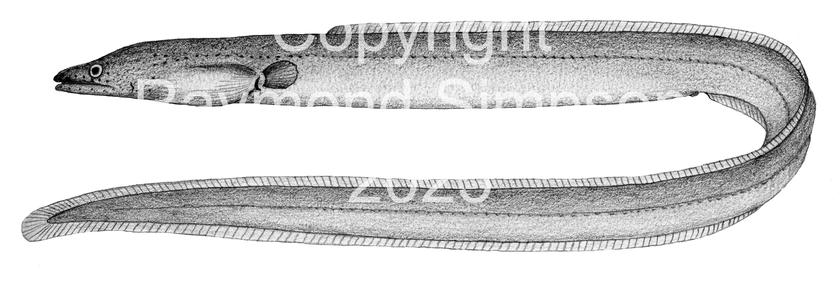
Common Name
Longfin Worm Eel
Year Described
McCosker, Böhlke & Böhlke, 1989
Identification
Vertebrae: 14-17 predorsal, 45-49 pre-anal, 135-147
Body elongate and laterally compressed. Trunk shorter than tail. Snout short, bluntly rounded and overhangs mouth. Eye over middle of jaw. Underside of snout without groove. Anterior nostril a well developed tube. Posterior nostril a small slit in upper lip under anterior eye. Teeth small and conical. Two rows of teeth on maxillary (25-30 outer, 15-16 inner) and dentary (26-30 outer and 18-20 inner). Intermaxillary teeth present (9-11) in a rounded patch connected to vomerine row. Vomer with one row of teeth (12-16). Gill openings small on lower side. Dorsal fin origin about as far as 1-2 pectoral fin lengths from gill slit or less than twice head length. Anal fin present. Dorsal and anal fins low and continuous around the tail. Anal fin higher than dorsal fin. Pectoral fin well developed (2X orbit) and rounded. Lateral line complete with only anterior pores easily visible. Head pores well developed. One postorbital pore.
Color
Pale brown to gray with a fine peppering of melanophores. Gut region often pinkish with organs visible through skin. Fins transparent to dusky.
Size
Maximum size to 161mm TL.
Habitat
Found in very shallow water (<2m) within sandy substrate.
Range
Southern Caribbean on continental coastlines from Colombia to Tobago.
References
Böhlke, E. B. (ed.). 1989. Volume One: Orders Anguilliformes and Saccopharyngiformes. Volume Two: Leptocephali. Fishes of the western North Atlantic. Memoirs of the Sears Foundation of Marine Research Mem. 1 (part 9): v. 1:i-xvii + 1-655; 2:i-vii + 657-1055.
Other Notes
The four W. Atlantic Myrophis are distinguished by dorsal fin origin position and vertebral counts. M. anterodorsalis and platyrhynchus are both small species but platyrhynchus has two postorbital pores.